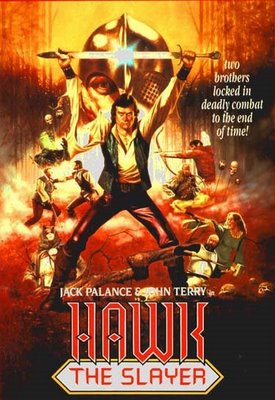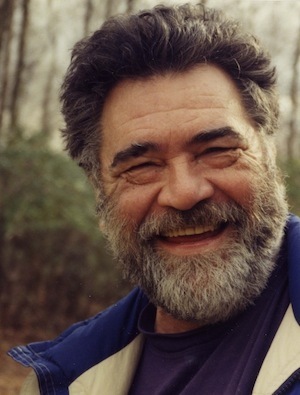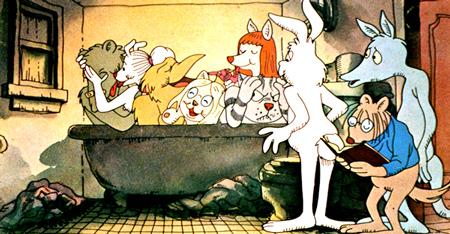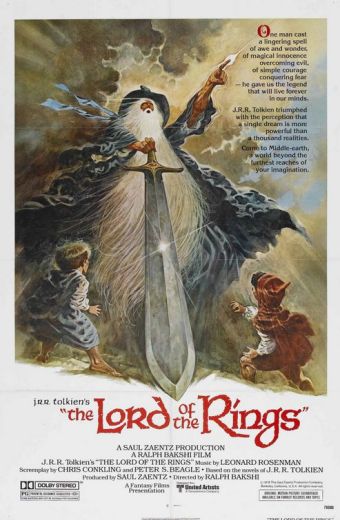(DISCLAIMER: This blog is not for profit. All images and footage used below are property of their respective companies unless stated otherwise. I do not claim ownership of this material. New to the blog? Start at the start with Snow White.)
My father was the one who introduced me to JRR Tolkien, giving me a dog-eared, well-thumbed chunk called The Lord of the Rings one summer when we were on holiday (I was maybe…eight, I guess? Pre-transformation anyway). I remember there was this weird picture on the cover of the Black Riders that looked sort of animated but also sort of not and I asked my father what it was from.
“That’s from the movie.” He said.
“There’s a movie?”
“Oh yeah. You have to see it.”
“Is it any good?”
“No. No, it’s awful.”
This was really the problem you had if you were a fantasy fan any time before the turn of the millennium:
We had no good movies.
Our brothers and sisters in the science fiction fandom had it pretty bad too of course, the vast majority of their movies were cheap schlock but at least they could point to a few straight up classics that even the hoity-toity critics had to admit were the real deal; Alien, 2001, Bladerunner.
Fantasy fans though? What did we have?

Truly, our cup ranneth over.
So if you were a fantasy fan in the seventies, eighties or nineties and you heard there was a Lord of the Rings movie, you had to see it even if it was terrible. Because it’s not exactly like you had a whole lot of options. The Lord of the Rings, the undisputed big swingin’ dick of the high fantasy genre, used to spend most of its time on lists of “unfilmable” books and with good reason. I can think of two periods in Hollywood history where a faithful film adaptation might have been possible. The first would be in the late fifties, when studios were creating gargantuan epics like Ben Hur and The Ten Commandments. The second would be now, the current era of movie history which (not coincidentally) was largely kick-started by Peter Jackson’s own Lord of the Rings trilogy. The current movie scene owes almost as much to The Lord of the Rings as the fantasy genre does. Planned trilogies, huge runtimes, massive battle scenes, copious amounts of CGI…so much of how movies are made, look and sound in the modern era can be laid at the feet of Peter Jackson (though we won’t hold that against him).
On the flipside, if I had to choose the worst possible time to try and make a Lord of the Rings movie (aside from, I dunno, the silent era) it would be the nineteen seventies. The seventies is often lauded as the greatest movie decade and it’s won that reputation for a slew of grungy, lo-fi, morally ambiguous classics. It was that kind of era (contrast that to 2001 when Jackson’s Fellowship of the Ring came out when everything seemed a good deal more black and white). So you have a decade where no one is really spending big money on movies anymore, epics are largely a thing of the past and the cultural zeitgeist is really not grokking a simple morality tale of noble heroes trying to defeat an evil lord of darkness who lives in a black spiky castle. Who (Who, I ask you?) would be a mad enough bastard to try and make a Lord of the Rings movie in the nineteen seventies?

When not animating, he keeps his drawing arm strong by wrasslin’ grizzlies.
Ralph Bakshi is one of the most famous (or at least notorious) American animators out there. Having made his bones in the Terrytoons studio (Heckle and Jeckle, Mighty Mouse and the like) he went on to create the animated adaptation of R. Crumb’s comic strip Fritz the Cat.

Oh sure. I’ll review it. If you can tell me what I say to my wife when she walks in on me watching the scene where all the animals have a bathtub orgy.
By 1969 the movie rights to The Lord of the Rings had found their way to United Artist’s, where Stanley Kubrick and John Boorman both had a crack at adapting it, with Boorman turning in a 700 page script that no one at the studio could even understand. Bakshi, who’d been obsessed with the idea of doing an animated version of the story since the fifties begged UA for the chance to direct. Impressed by Bakshi’s passion, UA junked Boorman’s script and told Ralph to go do his own version.
Bakshi was a true Tolkien die-hard and, in stark contrast to Boorman who had altered characters and plot points willy-nilly, wanted to do a movie version of the book that was as faithful as possible. Bakshi firmly believed that Tolkien was a genius who could do no wrong.

My rebuttal.
I can respect fidelity to the source material (and if anyone ever decides to do a movie of
The Hangman’s Daughter I’ll probably start respecting it a whole lot more) but ultimately I think this was the movie’s undoing. Being faithful to the text is all well and good if you have hundreds of millions of dollars and a New Zealand but if you’re trying to do the story in two moderately budgeted animated features (as was the plan) then you really need to start looking at the story with a gaze of grim determination and a pair of scissors clenched in one hand. Bakshi tried to fit as much of the book as possible into the movie and we’ll see further on the problems that this caused.
Bakshi made the decision to use rotoscoping, a technique he’d first used in his earlier animated feature
Wizards as a way of saving money. Rotoscoping is about as old as animation itself and basically involves drawing and painting over live action footage to create an animated effect. This has the upside of giving you more realistic movement and it tends to be cheaper and less labor intensive than traditional cel animation. Despite this, rotoscoping has traditionally been used more as a tool than a style. There’s plenty of instances of rotoscoping in animated movies (
Cruella De Ville’s Car, Edgar’s motorbike in
The Aristocats, The Giant Mouse of Minsk in
An American Tail) but it’s rare for it to be used for extended sequences and Bakshi’s
Lord of the Rings represents probably the most extensive use of the technique in a feature film until Richard Linklater’s
Waking Life in 2001 (and that was digital, rather than hand-drawn rotoscoping). Why is that? Well, part of the appeal of animation is that animated characters
don’t move like real people and can be stretched or distorted or flattened however the animator pleases. Another reason (and a big part of why all the examples I listed above are inanimate objects or vehicles) is that living characters that are rotoscoped tend to have their home address in the Uncanny Valley. No one had ever tried to make a movie that was almost entirely rotoscoped.
So. Untested animation techniques. Impossible to adapt source material. Certainty of death. Small chance of success.

“What are we waiting for?”
(more…)











